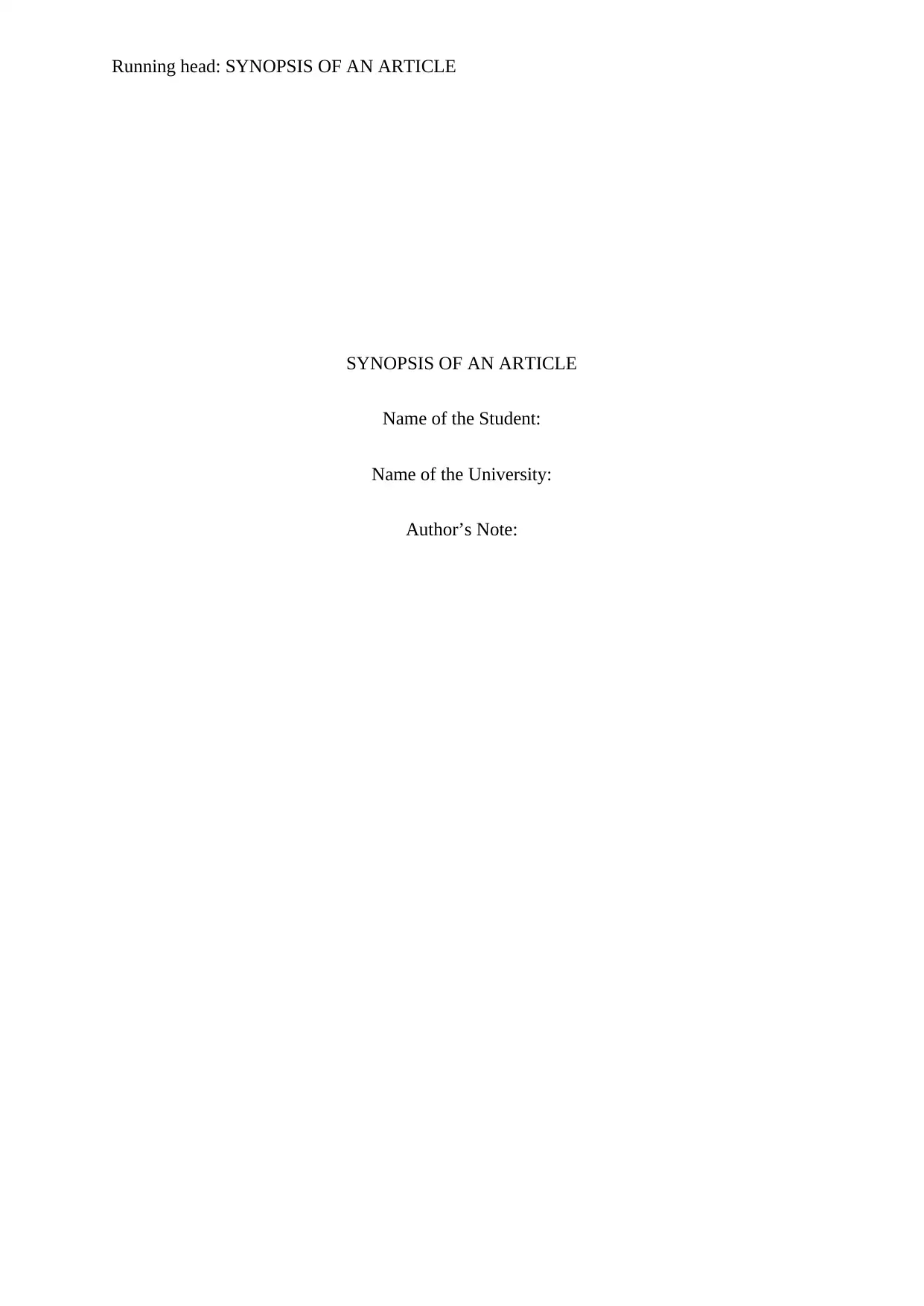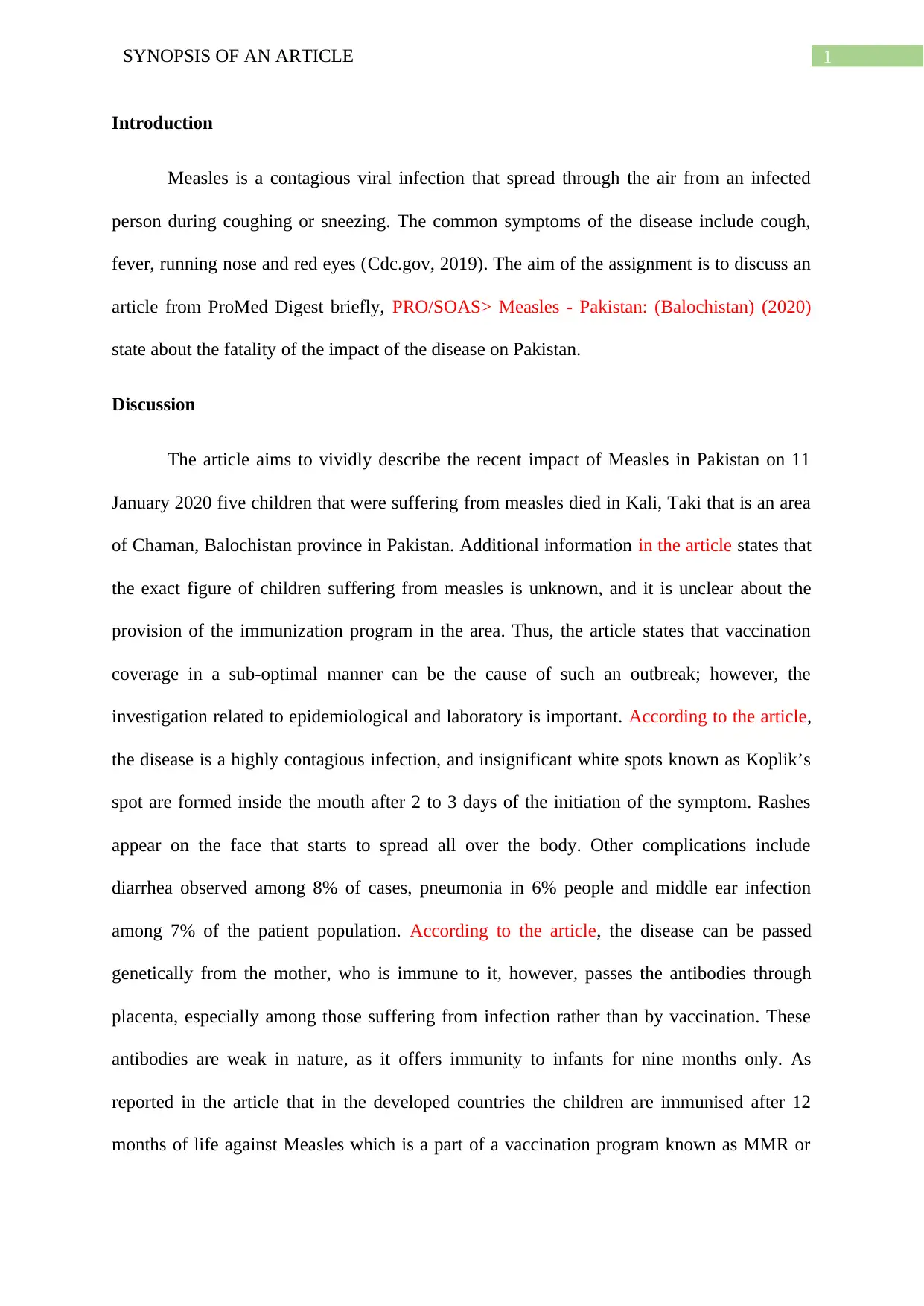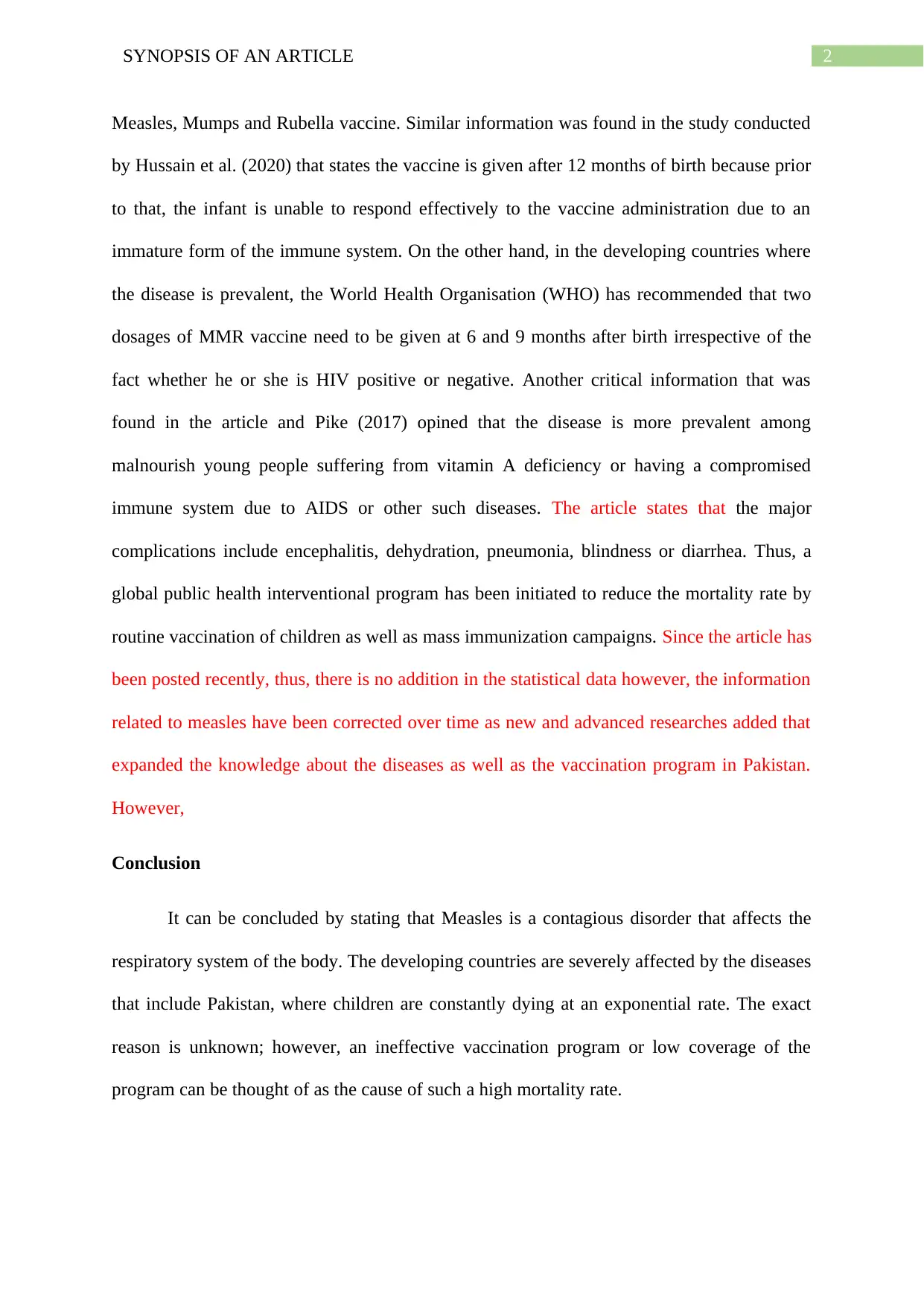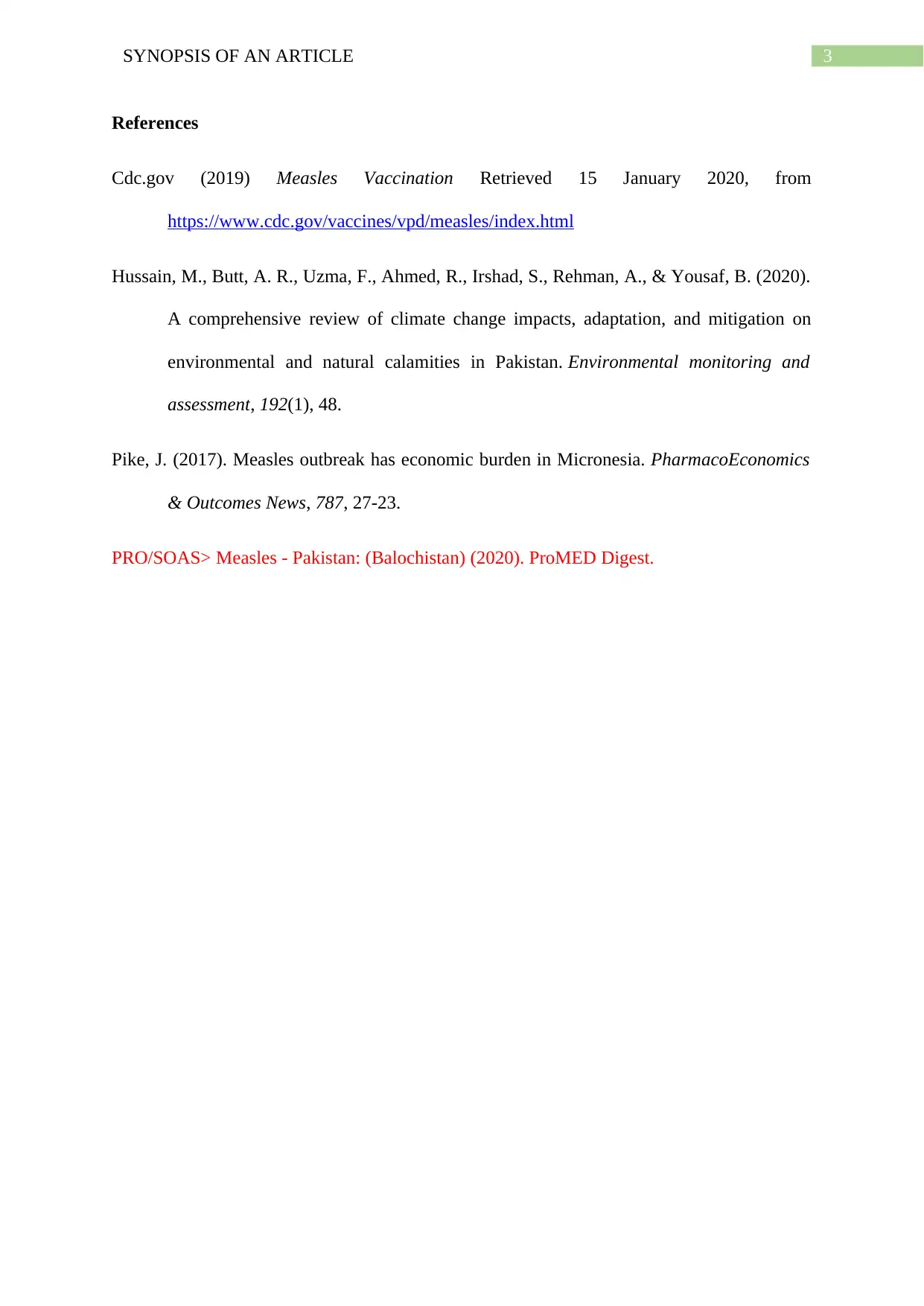Measles Outbreak in Pakistan: Article Synopsis and Analysis
VerifiedAdded on 2022/08/24
|4
|859
|29
Report
AI Summary
This report provides a synopsis of an article from ProMed Digest concerning a measles outbreak in Balochistan, Pakistan, in January 2020, where five children died. The report details the symptoms of measles, including cough, fever, and rash, and highlights the disease's contagious nature. It discusses the article's points on vaccination, the MMR vaccine, and the challenges in developing countries. The report also references the impact of malnutrition and vitamin A deficiency on measles severity. The conclusion emphasizes measles's impact on Pakistan and suggests an ineffective vaccination program as a potential cause of the high mortality rate. The report includes references to supporting studies and articles.

Running head: SYNOPSIS OF AN ARTICLE
SYNOPSIS OF AN ARTICLE
Name of the Student:
Name of the University:
Author’s Note:
SYNOPSIS OF AN ARTICLE
Name of the Student:
Name of the University:
Author’s Note:
Paraphrase This Document
Need a fresh take? Get an instant paraphrase of this document with our AI Paraphraser

1SYNOPSIS OF AN ARTICLE
Introduction
Measles is a contagious viral infection that spread through the air from an infected
person during coughing or sneezing. The common symptoms of the disease include cough,
fever, running nose and red eyes (Cdc.gov, 2019). The aim of the assignment is to discuss an
article from ProMed Digest briefly, PRO/SOAS> Measles - Pakistan: (Balochistan) (2020)
state about the fatality of the impact of the disease on Pakistan.
Discussion
The article aims to vividly describe the recent impact of Measles in Pakistan on 11
January 2020 five children that were suffering from measles died in Kali, Taki that is an area
of Chaman, Balochistan province in Pakistan. Additional information in the article states that
the exact figure of children suffering from measles is unknown, and it is unclear about the
provision of the immunization program in the area. Thus, the article states that vaccination
coverage in a sub-optimal manner can be the cause of such an outbreak; however, the
investigation related to epidemiological and laboratory is important. According to the article,
the disease is a highly contagious infection, and insignificant white spots known as Koplik’s
spot are formed inside the mouth after 2 to 3 days of the initiation of the symptom. Rashes
appear on the face that starts to spread all over the body. Other complications include
diarrhea observed among 8% of cases, pneumonia in 6% people and middle ear infection
among 7% of the patient population. According to the article, the disease can be passed
genetically from the mother, who is immune to it, however, passes the antibodies through
placenta, especially among those suffering from infection rather than by vaccination. These
antibodies are weak in nature, as it offers immunity to infants for nine months only. As
reported in the article that in the developed countries the children are immunised after 12
months of life against Measles which is a part of a vaccination program known as MMR or
Introduction
Measles is a contagious viral infection that spread through the air from an infected
person during coughing or sneezing. The common symptoms of the disease include cough,
fever, running nose and red eyes (Cdc.gov, 2019). The aim of the assignment is to discuss an
article from ProMed Digest briefly, PRO/SOAS> Measles - Pakistan: (Balochistan) (2020)
state about the fatality of the impact of the disease on Pakistan.
Discussion
The article aims to vividly describe the recent impact of Measles in Pakistan on 11
January 2020 five children that were suffering from measles died in Kali, Taki that is an area
of Chaman, Balochistan province in Pakistan. Additional information in the article states that
the exact figure of children suffering from measles is unknown, and it is unclear about the
provision of the immunization program in the area. Thus, the article states that vaccination
coverage in a sub-optimal manner can be the cause of such an outbreak; however, the
investigation related to epidemiological and laboratory is important. According to the article,
the disease is a highly contagious infection, and insignificant white spots known as Koplik’s
spot are formed inside the mouth after 2 to 3 days of the initiation of the symptom. Rashes
appear on the face that starts to spread all over the body. Other complications include
diarrhea observed among 8% of cases, pneumonia in 6% people and middle ear infection
among 7% of the patient population. According to the article, the disease can be passed
genetically from the mother, who is immune to it, however, passes the antibodies through
placenta, especially among those suffering from infection rather than by vaccination. These
antibodies are weak in nature, as it offers immunity to infants for nine months only. As
reported in the article that in the developed countries the children are immunised after 12
months of life against Measles which is a part of a vaccination program known as MMR or

2SYNOPSIS OF AN ARTICLE
Measles, Mumps and Rubella vaccine. Similar information was found in the study conducted
by Hussain et al. (2020) that states the vaccine is given after 12 months of birth because prior
to that, the infant is unable to respond effectively to the vaccine administration due to an
immature form of the immune system. On the other hand, in the developing countries where
the disease is prevalent, the World Health Organisation (WHO) has recommended that two
dosages of MMR vaccine need to be given at 6 and 9 months after birth irrespective of the
fact whether he or she is HIV positive or negative. Another critical information that was
found in the article and Pike (2017) opined that the disease is more prevalent among
malnourish young people suffering from vitamin A deficiency or having a compromised
immune system due to AIDS or other such diseases. The article states that the major
complications include encephalitis, dehydration, pneumonia, blindness or diarrhea. Thus, a
global public health interventional program has been initiated to reduce the mortality rate by
routine vaccination of children as well as mass immunization campaigns. Since the article has
been posted recently, thus, there is no addition in the statistical data however, the information
related to measles have been corrected over time as new and advanced researches added that
expanded the knowledge about the diseases as well as the vaccination program in Pakistan.
However,
Conclusion
It can be concluded by stating that Measles is a contagious disorder that affects the
respiratory system of the body. The developing countries are severely affected by the diseases
that include Pakistan, where children are constantly dying at an exponential rate. The exact
reason is unknown; however, an ineffective vaccination program or low coverage of the
program can be thought of as the cause of such a high mortality rate.
Measles, Mumps and Rubella vaccine. Similar information was found in the study conducted
by Hussain et al. (2020) that states the vaccine is given after 12 months of birth because prior
to that, the infant is unable to respond effectively to the vaccine administration due to an
immature form of the immune system. On the other hand, in the developing countries where
the disease is prevalent, the World Health Organisation (WHO) has recommended that two
dosages of MMR vaccine need to be given at 6 and 9 months after birth irrespective of the
fact whether he or she is HIV positive or negative. Another critical information that was
found in the article and Pike (2017) opined that the disease is more prevalent among
malnourish young people suffering from vitamin A deficiency or having a compromised
immune system due to AIDS or other such diseases. The article states that the major
complications include encephalitis, dehydration, pneumonia, blindness or diarrhea. Thus, a
global public health interventional program has been initiated to reduce the mortality rate by
routine vaccination of children as well as mass immunization campaigns. Since the article has
been posted recently, thus, there is no addition in the statistical data however, the information
related to measles have been corrected over time as new and advanced researches added that
expanded the knowledge about the diseases as well as the vaccination program in Pakistan.
However,
Conclusion
It can be concluded by stating that Measles is a contagious disorder that affects the
respiratory system of the body. The developing countries are severely affected by the diseases
that include Pakistan, where children are constantly dying at an exponential rate. The exact
reason is unknown; however, an ineffective vaccination program or low coverage of the
program can be thought of as the cause of such a high mortality rate.
⊘ This is a preview!⊘
Do you want full access?
Subscribe today to unlock all pages.

Trusted by 1+ million students worldwide

3SYNOPSIS OF AN ARTICLE
References
Cdc.gov (2019) Measles Vaccination Retrieved 15 January 2020, from
https://www.cdc.gov/vaccines/vpd/measles/index.html
Hussain, M., Butt, A. R., Uzma, F., Ahmed, R., Irshad, S., Rehman, A., & Yousaf, B. (2020).
A comprehensive review of climate change impacts, adaptation, and mitigation on
environmental and natural calamities in Pakistan. Environmental monitoring and
assessment, 192(1), 48.
Pike, J. (2017). Measles outbreak has economic burden in Micronesia. PharmacoEconomics
& Outcomes News, 787, 27-23.
PRO/SOAS> Measles - Pakistan: (Balochistan) (2020). ProMED Digest.
References
Cdc.gov (2019) Measles Vaccination Retrieved 15 January 2020, from
https://www.cdc.gov/vaccines/vpd/measles/index.html
Hussain, M., Butt, A. R., Uzma, F., Ahmed, R., Irshad, S., Rehman, A., & Yousaf, B. (2020).
A comprehensive review of climate change impacts, adaptation, and mitigation on
environmental and natural calamities in Pakistan. Environmental monitoring and
assessment, 192(1), 48.
Pike, J. (2017). Measles outbreak has economic burden in Micronesia. PharmacoEconomics
& Outcomes News, 787, 27-23.
PRO/SOAS> Measles - Pakistan: (Balochistan) (2020). ProMED Digest.
1 out of 4
Related Documents
Your All-in-One AI-Powered Toolkit for Academic Success.
+13062052269
info@desklib.com
Available 24*7 on WhatsApp / Email
![[object Object]](/_next/static/media/star-bottom.7253800d.svg)
Unlock your academic potential
Copyright © 2020–2025 A2Z Services. All Rights Reserved. Developed and managed by ZUCOL.





